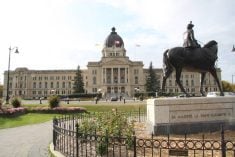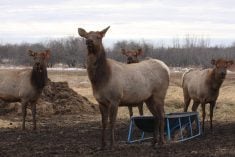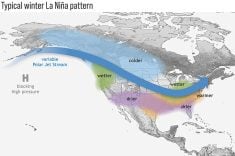During the height of the winter campaign for farm aid, protesters claimed that a vast amount of prairie farmland would go unseeded this spring and that many farmers would get out of the business altogether.
But that didn’t happen, according to Statistics Canada’s seeding intentions report.
Western Canadian farmers will be planting about 59.7 million acres of grains, oilseeds and pulse crops – up slightly from the 59.5 million acres seeded in 1999.
It’s a statistic that puzzles Pro-West Rally Group president Sharon Nicholson. She simply does not believe the numbers.
Read Also

Saskatchewan throne speech promises strong economy
Saskatchewan’s legislative agenda for the coming year will focus on meeting the challenges of new world trading relationships, said the speech from the throne.
“I think I would have to just disagree on that from the people that I’ve been talking to.”
Nicholson said a lot of farmers probably took advantage of the federal government’s interest-free cash advance program to put a crop in the ground this spring. She also thinks many farmers will be devoting a lot of land to summerfallow.
But Statistics Canada is forecasting 13.8 million acres of summerfallow, down eight percent from 1999.
University of Saskatchewan agricultural economist Gary Storey said he’s not surprised that this year’s crop may be every bit as big as last year’s.
“I didn’t suspect, even when I heard those things, that we were going to get the big cutback that these people were talking about.”
But giving the protesters the benefit of the doubt, Storey said there have been a few developments in the last three months that could have changed farmers’ minds about not seeding a crop.
He said grain markets have risen a little from their mid-winter lows.
“The other thing is of course the governments came through with some money to help farmers put a crop in.”
Back on tractor
Gail Forbes is one of the farmers who said she was getting out of the business. The Senlac, Sask., farmer told reporters that last year’s harvest was the last one for Forbes and her husband Murray.
But Murray is out in the fields once again this spring. Gail said they were unsuccessful in their endeavors to sell or rent the entire three-section operation over the winter.
“We had it all rented out to one fellow and then he backed out.”
The couple did manage to sell one section and rent out three quarters, but they will be reluctantly farming the remaining five quarters of land this year.
She said they are converting the farm from cultivated land into pasture, seeding 300 acres to grass this year. The remaining 300 acres will be seeded to wheat and then to grass the following year. They will be grazing 25 head of cattle on the pasture this summer.
Forbes believes they will have better luck trying to sell the farm as pastureland than they would as cultivated land.
The farm isn’t listed with a real estate agent right now because it’s too late in the year to be selling farmland, but it is still up for sale.
“We’re not going to focus on selling it right now, but if somebody was wanting to purchase it, yep, it’s always for sale.”
Once the farm is completely converted to pasture, the couple will concentrate on their other business of delivering equipment and supplies to oil companies.















